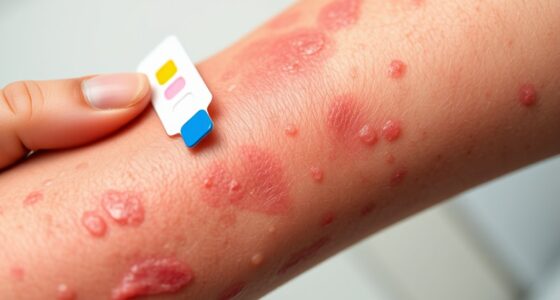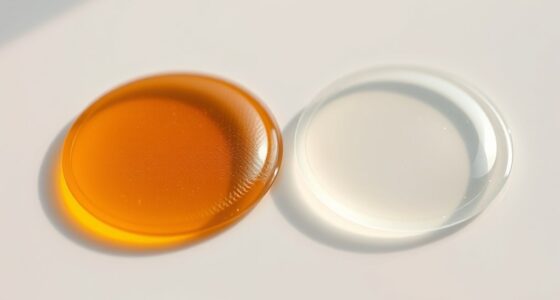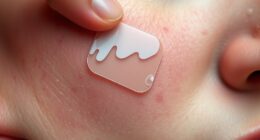When choosing skincare patches for sensitive skin, look for products with gentle, hypoallergenic ingredients free from fragrances, alcohol, and harsh chemicals. Always perform a patch test to check for reactions before full use. Pay attention to adhesives—opt for medical-grade or dermatologist-tested options to prevent irritation. Checking for clinical safety support can also boost confidence. If you want tips on selecting the safest patches, what ingredients matter most, and how to test them properly, keep going.
Key Takeaways
- Choose patches labeled as hypoallergenic and free from fragrances, alcohol, and harsh chemicals suitable for sensitive skin.
- Always perform a patch test on a small skin area for 24 hours before full use to check for irritation.
- Opt for patches with gentle, medical-grade adhesives to prevent additional skin irritation during wear.
- Look for products backed by clinical studies or safety certifications to ensure they are designed for sensitive skin.
- Gradually incorporate skincare patches into routines, prioritizing ingredient safety and skin comfort to avoid adverse reactions.

If you have sensitive skin, finding effective skincare solutions can be challenging. You want products that deliver results without causing irritation or discomfort. Skincare patches have gained popularity because they offer targeted treatment and convenient application. However, when considering patches for sensitive skin, ingredient safety is a top concern. Many patches contain active ingredients or preservatives that could potentially trigger reactions. That’s why it’s crucial to review the product’s ingredient list carefully. Look for gentle, hypoallergenic formulations free from fragrances, alcohol, and harsh chemicals. When in doubt, opt for patches that specify they’re suitable for sensitive skin.
Before fully incorporating a new patch into your routine, patch testing is essential. This small step helps you determine how your skin reacts without risking a full-blown reaction. To patch test, apply a small piece of the patch on an inconspicuous area, like behind your ear or on your inner wrist, and leave it on for 24 hours. During this period, monitor for redness, itching, or swelling. If any irritation occurs, remove the patch immediately and wash the area. If no adverse reactions appear, it’s generally safe to proceed with regular use. Patch testing is especially important because even products marketed as gentle or suitable for sensitive skin can sometimes cause unexpected reactions.
Another aspect to consider is how well the patch adheres without causing additional irritation. Some patches use adhesives that might be too harsh for sensitive skin, so look for products with dermatologist-tested or medical-grade adhesives. These are formulated to minimize irritation and maximize comfort during wear. Additionally, check whether the patch’s ingredients are backed by safety studies or clinical trials, which can give you added confidence in their safety profile.
Being aware of AI safety measures and how they relate to product development can also help you choose patches that are safer and more reliable, especially as technology advances to create better skin-friendly formulations.
Incorporating skincare patches into your routine can be beneficial, but always prioritize ingredient safety and patch testing. This proactive approach helps you avoid unnecessary discomfort and ensures the products work effectively for your skin type. Remember, sensitive skin requires gentle, deliberate choices, so take your time researching and testing new patches. With patience and care, you can find solutions that improve your skin’s health without compromising its sensitivity. Ultimately, your skin’s safety and comfort should always come first, guiding your decisions about skincare patches and other treatments.
Frequently Asked Questions
Are Skincare Patches Suitable for All Sensitive Skin Types?
Skincare patches aren’t suitable for all sensitive skin types, as patch material and adhesive strength vary. If you have highly sensitive skin, choose patches with gentle, hypoallergenic materials like hydrogel or silicone. Test a small area first to check for reactions. Avoid patches with strong adhesives or fragrances, and look for labels indicating suitability for sensitive skin. This way, you minimize irritation while benefiting from targeted skincare.
How Long Should I Leave a Patch on My Skin?
You should leave a skincare patch on your skin for the recommended patch application duration, usually between 8 to 24 hours, depending on the product. Pay attention to your skin’s response, as a slower skin absorption rate means longer wear might be needed for effectiveness. Always follow the instructions provided to avoid irritation or overexposure, and remove the patch once the suggested time has passed.
Can Skincare Patches Cause Allergic Reactions?
Sure, skincare patches can cause allergic reactions, even if they’re meant to soothe sensitive skin. Isn’t it ironic? If you have ingredient sensitivity, those patches might just backfire and trigger redness or irritation instead of helping. Always check the ingredients list, do a patch test first, and be cautious. Remember, what’s supposed to help might unexpectedly cause allergic reactions if your skin’s delicate.
Are There Natural or Hypoallergenic Patch Options?
Yes, there are natural and hypoallergenic patch options available. You should look for patches made with natural ingredients like aloe vera, chamomile, or green tea, which are gentle on sensitive skin. Hypoallergenic patches are specifically designed to minimize allergic reactions, using fewer potential irritants. Always check the ingredient list and do a patch test before applying a new patch to confirm it suits your skin.
How Often Can I Use Skincare Patches Safely?
You can usually use skincare patches once a day, but don’t forget about patch application frequency and patch longevity guidelines. Ironically, overusing them might do more harm than good, turning your skin into a patchwork quilt. Stick to the recommended timing, and your skin will thank you. Usually, a patch’s lifespan is a few hours, so follow the instructions carefully — your skin’s patience has limits!
Conclusion
So, if you’re seeking relief, if you’re aiming for comfort, if you’re craving gentle care, skincare patches for sensitive skin might be just what you need. They offer hydration, protection, and soothing benefits—all in one simple step. Remember, your skin deserves kindness, your skin deserves attention, your skin deserves the best. With the right patch, you can soothe your skin, restore your confidence, and embrace every day with a fresh, comfortable glow.









